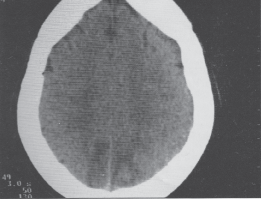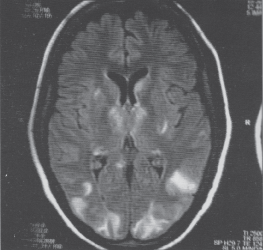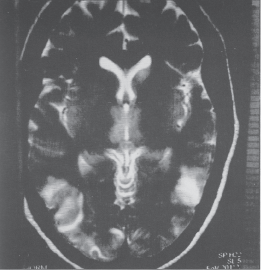Annals of Neurosciences, Vol 14, No 2 (2007)
Annals of Neurosciences, Volume 14, Issue 2 (April), 2007
REVERSIBLE POSTERIOR LEUKOENCEPHALOPATHY SYNDROME: A CASE REPORT
Corresponding author
Dr Rajesh Verma
Associate Professor
Department of Neurology,
King George Medical University
Lucknow-226003 Uttar Pradesh
e-mail:drrajeshverma@hotmail.com
Abstract
Reversible posterior leukoencephalopathy syndrome (RPLE) is now a recognized clinico-radiological entity, commonly associated with malignant hypertension, toxemia of pregnancy or with immunosuppressive and cytotoxic drugs. We present a young female who presented with posterior leukoencephalopathy syndrome due to fulminant toxemia of pregnancy.
Keywords: Toxemia of Pregnancy, Magnetic Resonance Imaging
Introduction
Posterior leukoencephalopathy syndrome is a rare clinico-radiological syndrome characterized by acute headache, seizures and cortical blindness. It usually presents in adults but has been reported in children. It occurs due to breakdown of autoregulation and endothelial function, usually associated with very high blood pressure or certain drugs. (1) Here we present a young female in last trimester of pregnancy who developed acute hypertension and sudden bilateral vision loss due to posterior leukoencephalopathy syndrome.

Fig-1 Computerized tomography scan of cranium revealing hypoattenuating lesions predominantly in posterior parieto- occipital area on both sides.

Fig-2 Magnetic resonance imaging T2 FLAIR depicting hyperintense lesions mainly in posterior parieto-occipital area on both sides with signal changes in lentiform nucleus
Case History
A twenty four years old female in last trimester of pregnancy approaching towards expected date of delivery developed acute headache for last four days. She consulted local physician and was detected hypertensive. She was prescribed antihypertensive medications. After two days of these complaints she developed severe headache, recurrent vomitings and drowsiness. One day afterwards she suddenly developed loss of vision on both sides. There was no history of seizures, hypertension during previous antenatal checkups, focal neurological deficits, joints pain, rashes over any part of body or drugs intake which can cause this type of complications. There was no history of renal failure, pallor, neuropathy, abnormal movements, or valvular heart disease. On examination pulse rate was 96/min, regular, synchronous without radio femoral delay. Blood pressure was 170/110 mmHg at the time of admission with no suggestion of postural hypotension. Pedal edema was present on both sides. Cardiovascular, Chest, Abdomnal examination did not reveal any abnormality. Higher mental status depicted drowsy state of the patient. Second cranial nerve assessment revealed bilateral loss of vision with only perception of light. Pupillary reflexes were normal, both direct and indirect consensual reactions. Fundus examination was normal. Rest all cranial nerves were intact. Motor, sensory and reflexes did not reveal any abnormality. On investigations Hb-10gm%, total leukocyte count 21,900, N-83%, E-1%, L-16, platelets count-1,43,000, Na/K-144/3.90, Liver function test revealed serum bilirubin-1.8, SGPT-54, SGOT-76 and TSH-5.090IU/nl and prothrombin time was 14 secs. Renal function test revealed serum creatinine-1.6mg/dl, urinary protein loss-900mg/24hrs. Plasma fibrin degradation products were 24.80microgram/nl. Computerized tomography of cranium showed bilateral hypodensities in parieto-occipital areas. Magnetic resonance imaging of cranium on T2 weighted and FLAIR clearly demonstrated hyperintense signal changes in posterior parieto-occipital areas. Based on these findings patient has been diagnosed as case of fulminant preeclampsia with posterior leukoencephalopathy syndrome. Patient was immediately delivered through caesarian section Patient was given antihypertensives and anti-edema agents mannitol, acetazolamide were started. After two days of emergent treatment patient vision was totally recovered.

Fig-3 Magnetic resonance imaging T2 weighted image showing hyperintense lesions mainly in posterior parieto-occipital area
Discussion
Reversible posterior leukoencephalopathy syndrome is a recently proposed cliniconeuroradiological entity characterized by seizures, disorders of consciousness, visual abnormalities and headaches associated with predominantly posterior white matter changes on computerized tomography head and magnetic resonance imaging. This is a rare encephalopathy condition, where the diagnosis depends on clinical and radiological features. It is rare but now being recognized more often. Most of the literature represents single or a few cases. It usually presents in adults but has been reported in children.(2)
This term was coined by Hinchey J et al in 1996. They found white matter edema on neuroimaging in the posterior temporo-parieto-occipital regions in a variety of conditions including severe hypertension, toxemia of pregnancy, use of immunosuppressive and cytotoxic agents. They proposed this term due to its specific location and relatively reversible nature.(3)
This syndrome is caused by hypertension, eclampsia, renal failure and those on immunosuppresants and chemotherapeutic agents.
Our patient was suffering from fulminant preeclampsia and later on developed severe hypertension and cortical blindness. The pathogenesis of this syndrome is disturbed arterial cerebrovascular autoregulation leading to extravasation of fluid into the brain parenchyma. The vulnerability of the posterior circulation may be explained by the paucity of autonomic innervation as compared to the anterior circulation. The resulting edema is usually vasogenic and reversible but may become cytotoxic in some patients. (4)
Neuroimaging findings in reversible leukoencephalopathy syndrome include non-enhancing white matter abnormalities, which produces low attenuation on computerized scan and hypointense signals on Tl weighted magnetic resonance imaging and hyperintense on T2 and FLAIR images. These lesions are mainly confined to posterior region of cerebral hemispheres(5). Echoplanar diffusion weighted imaging and apparent diffusion coefficient (ADC) maps are new magnetic resonance techniques which help in differentiating posterior leukoencephalopathy from ischemic events such as top of basilar artery syndrome which produces bilateral occipital infarction. Acutely infarcted areas are characterized by marked hyperintensity on diffusion weighted imaging and hypointensity on apparent diffusion coefficient maps. Conversely, in posterior leukoencephalopathy syndrome the regions of vasogenic edema are visualized as hypointense or isointense signals on diffusion weighted imaging and as markedly increased signals on ADC maps compared with normal tissue. (6)
In this patient emergent control of blood pressure was done and fetus was delivered through cesarean section on urgent basis. We also used anti-edema agents mannitol and acetazolamide for short duration. This patient showed very profound recovery. As per literature the treatment of this condition is early control of blood pressure, short term usage of antiepileptics and discontinuation of offending agents. We propose to use anti edema agents in addition to antihypertensives as important pathophysiology is vasogenic cerebral edema.
We have reported this case as to increased the awareness of this relatively recognized disorder among physicians and other clinicians, which has a good outcome with early diagnosis and prompt management. The early recognition of this syndrome is of great clinical significance as delay in the diagnosis and treatment can result in permanent neurological deficits.
References
1. Arroyo HA, Ganez LA, Fejerman N. Posterior reversible encephalopathy in infancy Rev Neurol 2003; 37:506–10
2. Schwartz RB. A RPLE Syndrome. N Engl J Med 1996; 334:1743
3. Hinchey J, Chaves C, Appignami B et al. A reversible leukoencephalopathy syndrome. N Engl J Med 1996; 334:494–500
4. Garg RK: Posterior leukoencephalopathy syndrome. Postgrad Med J 2001;77:24–28
5. Lamy C, Oppenheim C, Meder JF et al. Neuroimaging in posterior reversible encephalopathy syndrome. J Neuroimaging 2004; 14:89–96
6. Ay H, Buonanno FS, Schaefer PW et al Posterior leukoencephalopathy without severe hypertension: utility of diffusion weighted MRI Neurology 1998; 51:1369–76
(c) Annals of Neurosciences.All Rights Reserved